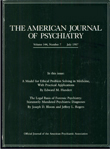Harry Stack Sullivan was one of the most important innovators and seminal thinkers in American psychiatry. He lived during the first half of the twentieth century, an era marked by intense excitement over psychoanalysis and the emergence of sociology and anthropology as fields of thought and endeavor. Sullivan was a synthesizer, bringing the contemporary ideas of psychiatry and social science together to form what has been called “social psychiatry.” The intellectual roots of the community mental health movement are found in Dr. Sullivan's work and writings.
Evans' book makes Sullivan's ideas accessible to us today. It is a refreshing review that often presents Sullivan's ideas more clearly than he did himself. The first part puts Sullivan's life and work in historical perspective. A loner and social outsider, Sullivan grew up in a rural community, experienced a troubled adolescence, and had an undistinguished academic and early work career. His arrival at Sheppard Pratt Hospital in 1922 signaled his emergence as a major innovator and thinker. He derived many of his concepts on interpersonal psychiatry while studying schizophrenia and what now we would call severe borderline conditions on a specially designed Sheppard Pratt research ward. The second part of Evans' book details Sullivan's interpersonal theory of psychiatry and his conception of humans as primarily social beings, emphasizing his departure from basic psychoanalysis and its emphasis on early sexual development. In addition to departing from Freud, Sullivan was also critical of Kraepelinian psychiatry with its emphasis on diagnostic categories, signs, and symptoms. He feared that descriptive psychiatry failed to look beyond diagnosis and view the whole person in his or her social context, recognizing the basic humanity of all human beings, including those who are most deeply psychotic. His focus was on what people had in common with each other rather than what separated them and on strengths and abilities that can be used to compensate for biopsychosocial dysfunction.
Sullivan conceptualized psychiatry as a social science and encouraged research into the common ground of sociology and mental illness. Along with the work of the cultural anthropologist Edward Sapir, the cultural anthropologist Ruth Benedict, and the political psychologist Harold Lasswell, Sullivan broke new ground in the understanding of the interaction between person and society, leaving a rich legacy for clinicians and researchers alike.
This book also reviews in some detail the application of Sullivan's theories to psychopathology and his unique contributions to psychotherapy. Sullivan developed an approach to psychotherapy that grew directly out of his theories of personality and mental disorder. Emphasizing the here and now, Sullivan's approach was to focus on the interpersonal relationship in order to alter inappropriate patterns of relatedness, patterns shaped by current and past experiences of anxiety, insecurity, and avoidance. Evans' final chapter on the psychiatric interview is especially useful to clinicians who wish to treat more severe psychiatric disorders with psychotherapy in addition to medication.
Sullivan would be especially critical and sarcastic regarding the trends today toward ultra-short-term interventions and managed care. His life and his work are important to remember as we reinvent ourselves for the twenty-first century.

